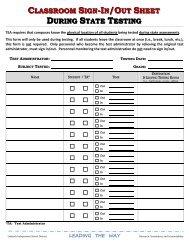Guidelines for Co-Teaching in Texas - Region 17
Guidelines for Co-Teaching in Texas - Region 17
Guidelines for Co-Teaching in Texas - Region 17
You also want an ePaper? Increase the reach of your titles
YUMPU automatically turns print PDFs into web optimized ePapers that Google loves.
Frequently Asked Questions1. I hold dual certification <strong>in</strong> both general and special education. Can I serve <strong>in</strong> both roles<strong>in</strong> the classroom?No. A teacher may not serve simultaneously as both general and special educator <strong>in</strong> grades K-12.Excerpt from the 2010-2011 Student Attendance Account<strong>in</strong>g Handbook (p. 90): A student with disabilitiesreceives specially designed <strong>in</strong>struction (as def<strong>in</strong>ed <strong>in</strong> 4.6.11 <strong>Co</strong>de 40 – Special Education Ma<strong>in</strong>stream).The specially designed <strong>in</strong>struction documented <strong>in</strong> the IEP is provided by special education personnel.One teacher, even if dually certified, may not serve <strong>in</strong> both a general education and a special educationrole simultaneously when serv<strong>in</strong>g students <strong>in</strong> grades K–12. Students with disabilities who are ages 3 or4 may have an <strong>in</strong>structional arrangement/sett<strong>in</strong>g code of 40, ma<strong>in</strong>stream, if special education servicesare provided <strong>in</strong> classroom sett<strong>in</strong>gs with nondisabled peers. The only context <strong>in</strong> which a dually certifiedteacher may serve <strong>in</strong> both a general education and a special education role is <strong>in</strong> an Early ChildhoodProgram <strong>for</strong> students ages 3 or 4.The Student Attendance Account<strong>in</strong>g Handbook can be found <strong>in</strong> its entirety at:http://www.tea.state.tx.us/<strong>in</strong>dex2.aspx?id=7739&menu_id=645&menu_id2=789.2. I am a certified deaf educator <strong>in</strong> a co-teach<strong>in</strong>g sett<strong>in</strong>g. Is a sign language <strong>in</strong>terpreter necessarywhen I am <strong>in</strong> the room?Yes. To serve <strong>in</strong> the role of an <strong>in</strong>terpreter, 19 TAC §89.1131 requires the <strong>in</strong>dividual to hold a valid<strong>in</strong>terpreter certification through the <strong>Texas</strong> Board <strong>for</strong> Evaluation of Interpreters (BEI), Registry ofInterpreters <strong>for</strong> the Deaf (RID), or be a certified member of RID. There<strong>for</strong>e, be<strong>in</strong>g a certified teacher of thedeaf does not qualify the teacher to serve as an <strong>in</strong>terpreter <strong>for</strong> students who are deaf or hard of hear<strong>in</strong>g <strong>in</strong>a general education classroom.In the event that a deaf educator is also a certified <strong>in</strong>terpreter, the deaf educator should not be expectedto serve <strong>in</strong> both roles simultaneously. <strong>Co</strong>-teach<strong>in</strong>g requires that both teachers are actively engaged<strong>in</strong> plann<strong>in</strong>g, delivery, and evaluation of <strong>in</strong>struction. Serv<strong>in</strong>g <strong>in</strong> the role of an <strong>in</strong>terpreter limits the deafeducator’s ability to accommodate, modify (i.e., modified grammar or vocabulary), keep up with thelesson, and provide the necessary supplementary aids, services, and specially designed <strong>in</strong>struction tohelp students meet <strong>in</strong>structional objectives. If the deaf educator is serv<strong>in</strong>g as the <strong>in</strong>terpreter, it shouldnot be considered co-teach<strong>in</strong>g and IEP teams may need to consider whether a teacher of the deaf or acertified <strong>in</strong>terpreter would best meet the needs of the student.3. If I am paid with special education funds, am I allowed to work with students who do not receivespecial education services?Yes. In a co-teach<strong>in</strong>g sett<strong>in</strong>g, general and special educators share the responsibility of teach<strong>in</strong>g allstudents <strong>in</strong> the classroom; there<strong>for</strong>e, both teachers are expected to support all students. S<strong>in</strong>ce bothteachers possess expertise <strong>in</strong> a variety of areas (i.e., curriculum, differentiation), they work as a teamto determ<strong>in</strong>e the unique needs of all students and use flexible group<strong>in</strong>g configurations to assurethat students with similar needs receive the support necessary to meet <strong>in</strong>structional objectives.Thisarrangement may require co-teachers to work with different groups that may or may not <strong>in</strong>clude studentswho are identified as hav<strong>in</strong>g disabilities. Depend<strong>in</strong>g on the <strong>in</strong>tensity of the necessary accommodationsand modifications, the teachers decide who would be best to lead whole or small group activities.50 | <strong>Texas</strong> <strong>Co</strong>-<strong>Teach<strong>in</strong>g</strong> <strong>Guidel<strong>in</strong>es</strong> <strong>Texas</strong> Education Agency / Education Service Center, <strong>Region</strong> 20
















